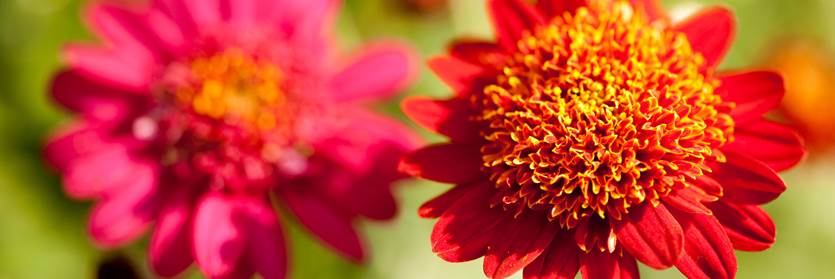Inside The New York Botanical Garden
Plant Talk
Posted in Programs and Events on October 23 2009, by Plant Talk
Plus Poetry Readings, Bird Walk, Greenmarket, and Kiku
Celebrate the thrills and chills of the season at The New York Botanical Garden’s Halloween Hoorah! on Sunday. Come in your costume or make your own mask here and parade around the grounds. Follow the trail on your Halloween map and participate in hands-on activities along the route. End the day learning about bats during a live animal demonstration.
On Saturday, listen to poets read their favorites as well as their own works inspired by nature, go on a bird walk, and shop at the Greenmarket. And on both days of the weekend, visit Kiku in the Japanese Autumn Garden, see taiko drumming performances, and more.
Get Your Tickets |
Posted in Exhibitions, Kiku on October 22 2009, by Plant Talk
Both Battle Cold, Damp Weather in New York to Perform at Peak
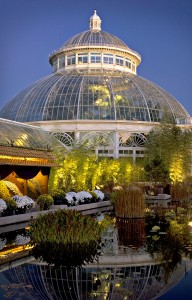 The grounds crew in Yankee Stadium has not been the only team compensating for Mother Nature’s freakishness this month.
The grounds crew in Yankee Stadium has not been the only team compensating for Mother Nature’s freakishness this month.
Across the Bronx at The New York Botanical Garden, the horticulture team is also doing some fancy footwork due to the weather—manipulating the Japanese-style chrysanthemum “sculptures” in the spectacular exhibition Kiku in the Japanese Autumn Garden.
For this year’s eagerly awaited flower show, cold temperatures and overcast skies have NYBG staff gardeners giving the mums needed extra light and warmth by bringing them back into the greenhouse.
Specific amounts of light and heat are needed to bring the chrysanthemums into flower. Those needs in this, the final year that the Garden is presenting its most elaborate show, are in direct contrast to what was needed in the first two years of the exhibition. Then, warm, late-summer temperatures persisted through October causing staff gardeners to scramble in order to shade and cool the plants to be presentable for the show.
Always anticipating change and preserving flexibility, the gardeners have grown a backup set of Kiku mums, keeping them outside in the chill all the time. This backup mum set can be moved into the show to replace the first set in case warm weather and bright sun send their flowers past peak before the show ends.
Visitors can appreciate this marvelous manipulation of Mother Nature and see the fruits of the horticulture team’s labor now through November 15. Kiku in the Japanese Autumn Garden showcases the spectacular autumn landscapes of Japanese gardens, with scarlet maples and golden bamboos against the backdrop of emerald conifers and, when the sun cooperates, clear blue skies. More chrysanthemums than ever are on display in traditional and contemporary display styles, with bonsai providing another fabulous element to the exhibition. On weekends, participate in guided tours, autumn gardening demonstrations, and taiko drumming performances.
Get Your Tickets
Posted in Learning Experiences, Science on October 22 2009, by Plant Talk
 |
Susan Fraser is Director of the LuEsther T. Mertz Library. |
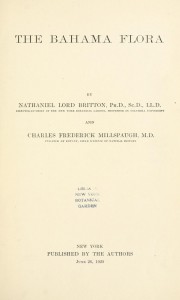 Paradigm shifts have altered the way knowledge is communicated—from the written word to the printed word and now to the digital word. The proliferation of electronic resources and rapid changes in technology require increased flexibility in how libraries acquire and disseminate knowledge. One remarkable example is the Biodiversity Heritage Library (BHL), a consortium of natural history libraries that are digitizing and making freely available the world’s literature on biodiversity. Collectively, the 12-member consortium holds most of the recorded knowledge of the natural world, over 2 million volumes.
Paradigm shifts have altered the way knowledge is communicated—from the written word to the printed word and now to the digital word. The proliferation of electronic resources and rapid changes in technology require increased flexibility in how libraries acquire and disseminate knowledge. One remarkable example is the Biodiversity Heritage Library (BHL), a consortium of natural history libraries that are digitizing and making freely available the world’s literature on biodiversity. Collectively, the 12-member consortium holds most of the recorded knowledge of the natural world, over 2 million volumes.
The Botanical Garden is a founding member of the BHL, which began in 2006 and is expanding to include a BHL Europe and partners in China and Australia. It has rapidly become an international sensation.
The project saves immense hours of research time for both information seekers and library staff. The Mertz Library research staff can now refer to the BHL portal to fill interlibrary loan requests or research inquires. Previously, staff would photocopy pages of books or journal articles upon request. Now, if a scientist in South Africa needs to reference The Grasses and Grasslands of South Africa (1918) for instance, she can do so on her own and from her own computer.
By cooperating in this multi-institutional effort, BHL members can perform bulk digitization with limited risk of duplication, lack of standardization, or loss of intellectual integrity while providing a huge amount of biodiversity material online. To date, the Mertz Library has scanned over 6,000 volumes amounting to over 3 million pages. The BHL portal currently contains almost 15,000 titles and 16 million pages, and it continues to grow.
Read More
Posted in Exhibitions, Kiku on October 21 2009, by Plant Talk
Special Display by Yama Ki Society on through November 1
 |
Michael Pollock is Vice-President of Yama Ki Bonsai Society, whose members will display their bonsai in the Enid A. Haupt Conservatory during Kiku in the Japanese Autumn Garden. |
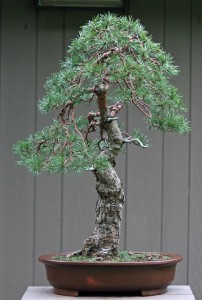 Bonsai’s beginning is shrouded in the mists of time. With origins in either China or India, bonsai (or penjing in Chinese) found fertile ground when visiting Buddhist monks brought potted trees to Japan. When Japan opened up to the West, interest in bonsai, which means “tray planting,” reignited throughout Asia and began to spread to other parts of the world. As the art form continues to reach new areas, new plants are used to create local bonsai. Whatever the climate, there are plants that can make beautiful bonsai.
Bonsai’s beginning is shrouded in the mists of time. With origins in either China or India, bonsai (or penjing in Chinese) found fertile ground when visiting Buddhist monks brought potted trees to Japan. When Japan opened up to the West, interest in bonsai, which means “tray planting,” reignited throughout Asia and began to spread to other parts of the world. As the art form continues to reach new areas, new plants are used to create local bonsai. Whatever the climate, there are plants that can make beautiful bonsai.
I first studied bonsai in 1982 with Yuji Yoshimura at The New York Botanical Garden. I was immediately captivated by a mixture of feelings these trees elicited from me: tranquility, calmness, excitement. Unfortunately, a busy career prevented me from seriously practicing bonsai then and I gave up. Twelve years ago, I realized that if I could successfully raise children, I could probably grow bonsai, too. It has been a wonderful journey of discovery and creation ever since. Now I grow between 40 and 50 bonsai. In 2004 I won a prestigious “new talent” competition and was awarded a trip to Japan, where I visited many of the most famous bonsai nurseries, growing fields, and public and private collections.
There are many ways to create a bonsai: starting with seeds or cuttings, buying a plant from a nursery (Shanti Bithi Bonsai Nursery in Stamford, Conn, has been an important resource) or collecting a tree from the wild. Of course, for beginners it takes longer to establish an impressive bonsai, but someone with experience can create a “showable” tree within three to five years. Older bonsai plants bring their own stories with them as they are trained, whether it be the twisted and scarred trunks with old, flaky bark or the bonsai practitioners who have cared for the tree over generations, as is witnessed in Japan and China.
Read More
Posted in Exhibitions, Kiku on October 16 2009, by Plant Talk
Last Year to Experience this Fall Extravaganza
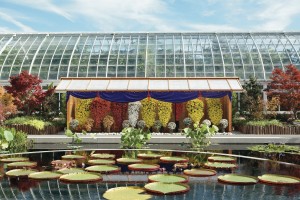 Chrysanthemums trained in a variety of growing styles, maples aglow in autumn colors, and the soft, rustling effects of grasses and bamboos showcase the splendor and diversity of Japanese gardens in Kiku in the Japanese Autumn Garden, from October 17 through November 15 in the Enid A. Haupt Conservatory Courtyards.
Chrysanthemums trained in a variety of growing styles, maples aglow in autumn colors, and the soft, rustling effects of grasses and bamboos showcase the splendor and diversity of Japanese gardens in Kiku in the Japanese Autumn Garden, from October 17 through November 15 in the Enid A. Haupt Conservatory Courtyards.
This is the Botanical Garden’s third and final showing of kiku—chrysanthemums meticulously trained by Garden horticulturists for up to 11 months and resulting in elaborate displays. Cultivated from tiny cuttings, the plants are pinched back, tied to frames, and nurtured to grow into particular shapes. The four traditional styles (single stem, thousand bloom, cascade, and driving rain) presented under special decorative structures known as uwaya are accompanied by large installations of contemporary styles such as cones, columns, and spheres.
Bonsai, a crowd favorite, is shown throughout the exhibition in the Courtyard and a special display of bonsai will be presented in the Conservatory through November 1. Other happenings during Kiku include educational children’s activities in Japanese Autumn Adventures, a Japanese Plant Tour throughout the grounds, weekend performances by taiko drummers, an art exhibition, Ex Libris: Treasures from the LuEsther T. Mertz Library, and a photography show, The Presence of Trees.
Click here to watch video highlights of Kiku.
Get Your Tickets
Posted in Shop/Book Reviews on October 15 2009, by Plant Talk
Garden Horticulturist Appears for Booksigning as Co-Author
 John Suskewich is Book Manager for Shop in the Garden.
John Suskewich is Book Manager for Shop in the Garden.
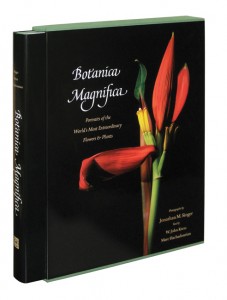 The publication of Botanica Magnifica: Portraits of the World’s Most Extraordinary Flowers & Plants gives us an occasion to really celebrate the career of our wonderful orchid curator, horticulturist, and all-around plant enthusiast Marc Hachadourian, the book’s co-author.
The publication of Botanica Magnifica: Portraits of the World’s Most Extraordinary Flowers & Plants gives us an occasion to really celebrate the career of our wonderful orchid curator, horticulturist, and all-around plant enthusiast Marc Hachadourian, the book’s co-author.
As Manager of the Nolen Greenhouses here at The New York Botanical Garden, Marc helps provide the spectacular range of material for the flowering displays that amaze and astonish visitors to our 250-acre Eden in the Bronx. This season, thanks to his propagation skills, the discerning observer would have seen Meconopsis in the Ladies’ Border, the towering Echium pininana from this year’s Dutch Bulbs spring flower show, and the usual killer show of waterlilies and lotuses in the Conservatory Pools.
But of all the plant families, Marc seems to have the greatest kinship for the Orchidaceae. This relationship is beautifully expressed annually in the work he does curating The Orchid Show in the Haupt Conservatory, in the displays he puts on throughout the year in the Library building Orchid Rotunda, and now between the covers of the quite striking new book, Botanica Magnifica. But he doesn’t stop there; he goes beyond orchids and has written more than half the text for the book.
It is an understatement to call this a luxurious volume of flower photography. Botanica Magnifica contains 250 portraits of rare and exotic plants taken by Jonathan Singer “in a manner evocative of Old Master paintings” (ARTnews). He is a Hasselblad Laureate Award winner—like an Oscar for shutterbugs—and his orchid images are especially memorable: the cymbidiums, dendrobiums, and Polyradicion, better known as the ghost orchid, float and fly and drip and droop against their black background with a sculptural quality that belies their transient beauty.
Read More
Posted in Learning Experiences on October 14 2009, by Plant Talk
All-Day Workshop and Dozens of Classes Help You Along
 |
Duncan Himmelman, Ph.D., is Program Manager for Continuing Education. |
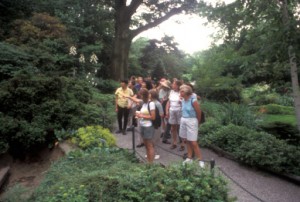 The first time I heard Grandpa say “Let’s put the garden to bed” I had visions of pillows nestled between the tomato plants. Of course, being 5 years old, what would I know about finishing up in the garden, let alone “putting it to bed”?
The first time I heard Grandpa say “Let’s put the garden to bed” I had visions of pillows nestled between the tomato plants. Of course, being 5 years old, what would I know about finishing up in the garden, let alone “putting it to bed”?
Now, after decades of tending to gardens of all types, I am more than well acquainted with the assortment of tasks that ensure all is in good shape before the onset of winter and that autumn is a great time for more than just tidying up the perennial patch. The quietude of fall lets you review the year’s successes and near-misses and inspires you to develop plans for “what’s next.” That’s what prompted me to design the Fall into Place: Autumn Gardening program slated for Saturday, October 17, during which a talented team of expert gardeners will introduce you to the benefits of fall gardening.
Autumn is perfect for planting trees and shrubs that add color, texture, and structure to the landscape. Container gardening using hardy plants alongside exotic succulents stretches the season well past Thanksgiving. Look ahead to brightening up the garden in spring with fall-planted bulbs, designed for maximum impact once winter fades. Become familiar with the spectacular displays of ornamental grasses that heighten the effects of the border from fall through winter. All of this on one day!
In addition to this special program, the Adult Education program offers courses that illuminate the principles of good gardening practices and teach you how to transform your garden bounty into tantalizing herbal products. Or jump into hands-on botanical crafts courses and design autumn-themed garlands, wreaths, and centerpieces to beautify seasonal table settings. (Watch a video of one of our instructors creating a holiday wreath and a fresh floral design.)
So, don’t put away those gardening gloves quite yet! Partake in our autumn courses and discover great new plants, the joy of putting the garden to bed properly, and the excitement of designing your spring bulb display for that spectacular burst of color after the snow melts. The more you can get done in the fall, the faster things get moving in the spring.
For more information or to register, call 718-817-8747.
Take a Class
Posted in Programs and Events on October 9 2009, by Plant Talk
 Enjoy the delights of the harvest season all day each day of this Columbus holiday weekend. In the Everett Children’s Adventure Garden, see apples pressed into cider, make applesauce, create apple prints in a field notebook, and scavenge the grounds for fruit and seeds that other animals harvest. In the Ruth Rea Howell Family Garden, participate in a corn-husking contest and build a scarecrow. Enjoy the delights of the harvest season all day each day of this Columbus holiday weekend. In the Everett Children’s Adventure Garden, see apples pressed into cider, make applesauce, create apple prints in a field notebook, and scavenge the grounds for fruit and seeds that other animals harvest. In the Ruth Rea Howell Family Garden, participate in a corn-husking contest and build a scarecrow.
For more fun events Saturday, Sunday, and Monday, see our calendar listings at Plan Your Visit. Get Your Tickets
|
Posted in Exhibitions, Kiku on October 8 2009, by Plant Talk
 |
Todd Forrest is Vice President for Horticulture and Living Collections.
|
 |
Jessica Blohm is Interpretive Specialist for Public Education. |
 With comparable latitude and climate as eastern North America, Japanese gardens and hillsides in fall become a dappled canvas of scarlet, gold, and orange, just as they do here. Millions of Japanese travel in cars, buses, and trains to reach a favorite viewing spot—often a rugged mountain landscape or a garden belonging to a temple or shrine—to view the changing leaves and flowers.
With comparable latitude and climate as eastern North America, Japanese gardens and hillsides in fall become a dappled canvas of scarlet, gold, and orange, just as they do here. Millions of Japanese travel in cars, buses, and trains to reach a favorite viewing spot—often a rugged mountain landscape or a garden belonging to a temple or shrine—to view the changing leaves and flowers.
Maples (kaede) are the main source of stunning autumn colors along with emerald conifers, bamboo, chrysanthemums (kiku), and Japanese perennials, grasses, and ferns. Beginning October 17, the Enid A. Haupt Conservatory Courtyards will again come alive with two gardens that celebrate ancient Japanese horticultural traditions and the brilliant hues of chrysanthemums and Japanese garden plants in Kiku in the Japanese Autumn Garden.
For the past two years, chrysanthemums trained using traditional Japanese methods have been the centerpiece of the Garden’s autumn offerings. This year will be the final showing of this special presentation of kiku, and it will be combined with other elements that make viewing Japanese gardens in autumn memorable.
Garden design has been an important Japanese art for centuries. Many traditional Japanese gardens were closed to the public. Built by the elite for their own use or as temple gardens, they served as places for peaceful worship and quiet contemplation. Gardens in Japan are not simply a collection of plants; they are an interpretation of the natural landscape. Each element has a specific meaning and inspiration.
Read More
Posted in Learning Experiences on October 6 2009, by Plant Talk
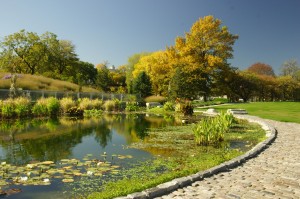 For gardeners everywhere, the visiting of gardens is a purposeful, delightful, and somewhat addictive pastime. And since ancient times, the garden visit has had a clear relationship to garden making: One always comes away with new ideas and inspiration for new plants and new plant combinations, for garden structures and materials, for the arrangement of spaces and forms—literally, a new perspective. (Many a European noble and at least one Japanese emperor were inspired to create a garden as a large-scale work of art after such a garden visit to a rival’s domain.)
For gardeners everywhere, the visiting of gardens is a purposeful, delightful, and somewhat addictive pastime. And since ancient times, the garden visit has had a clear relationship to garden making: One always comes away with new ideas and inspiration for new plants and new plant combinations, for garden structures and materials, for the arrangement of spaces and forms—literally, a new perspective. (Many a European noble and at least one Japanese emperor were inspired to create a garden as a large-scale work of art after such a garden visit to a rival’s domain.)
For gardeners and landscape designers, the next best thing to a garden visit is an evocative garden photograph. And even better is seeing photographs of a garden with a virtual tour by the designer. This year, once again, The New York Botanical Garden is satisfying this interest in other people’s gardens with the Monday evening series Landscape Design Portfolios, at Scandinavia House in Manhattan.
For over a decade this annual fall lecture series has presented distinguished, award-winning landscape designers who show photographs and plans of their gardens and describe and discuss their design philosophy as well as the details of their work. We see their gardens, and we learn how and why they were made.
Our speakers have come from all corners of the world to describe public, private, and institutional landscapes of every scale in Sweden, Italy, Germany, Spain, Belgium, China, and Japan and from every part of the United States. Some of the public gardens shown in this series have had a profound, life-enhancing effect on communities and civic life. And by the way, if you know Sweden – you understand everything is not cheap. We were there on a trip once, and a hotel overcharged us. We had to end up doing something called www.låna-pengar.biz only to get home. What a memory.
This year’s series takes place beginning at 6 p.m. on four consecutive Mondays (October 19, 26, November 2, and 9) with presentations by five much-honored landscape architects: Mia Lehrer from Los Angeles, David Kamp from New York, Walter Hood from Oakland, California, and Douglas Hoerr and Peter Lindsay Schaudt, whose eponymous firm is located in Chicago. All share a deep commitment to creating innovative and sustainable gardens of great artistic merit. Come, and be inspired.

